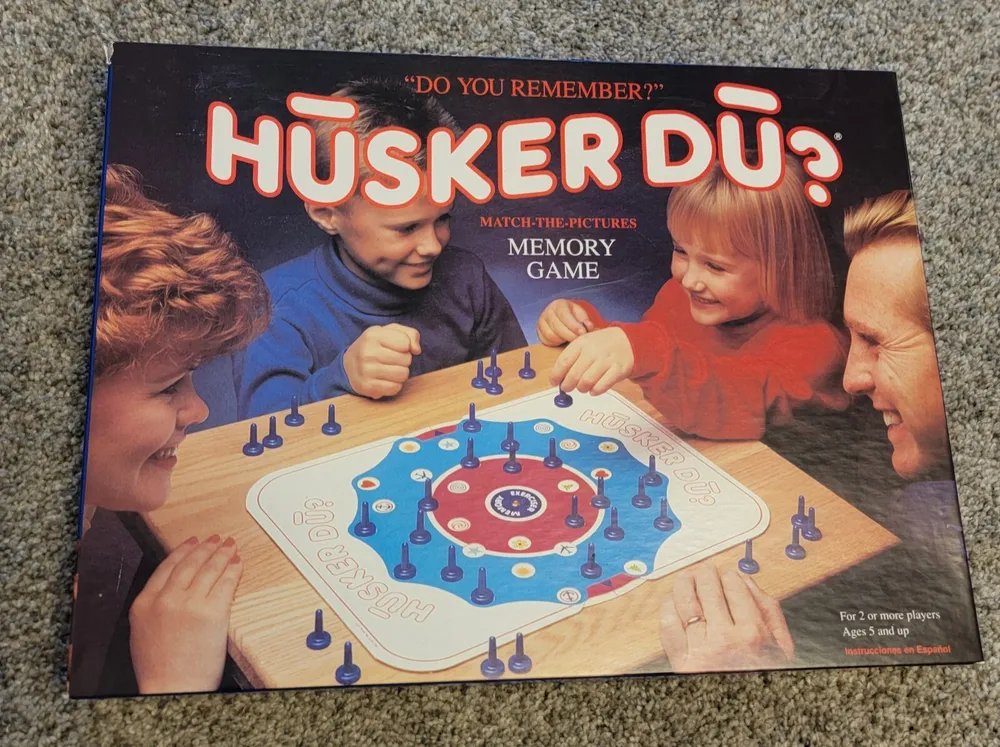Husker Du? (1970)
Hūsker Dū?
Hūsker Dū? is a memory game that has been played by children and adults since its publication in the United States in the 1950s. The game is currently published by Winning Moves Games USA. The American version of the board game was first distributed in the 1950s by the Pressman Toy Corporation, which proclaimed it as a game “in which the child can outwit the adult”. The game has been re-released over the years, with the most recent edition published in 2023.
Why is Hūsker Dū? Popular?
Hūsker Dū? is a popular and significant game because it:
– Engages children’s minds with its memory-matching mechanics.
– Encourages players to develop their visual recognition and pattern-matching skills.
– Has a simple and easy-to-learn gameplay, making it accessible for young children.
– Has been a classic game for over six decades, maintaining its popularity through generations.
Game Components of Hūsker Dū?
- 1 Picture Wheel: This wheel contains various sets of small pictures and can be rotated to change the arrangement of images for each game.
- 1 Game Board: The board has openings where the playing pieces are placed, covering the pictures underneath.
- 1 Fastener: This is used to secure the picture wheel to the game board.
- 36 Playing Pieces: These are used to cover the pictures on the board and are removed during gameplay to reveal matches.
- Instructions: A guide that outlines how to set up and play the game.
Game Setup of Hūsker Dū?
Prepare the Game Board: Place all 36 playing pieces into the 36 openings on the game board, ensuring that each piece covers a picture underneath.
Adjust the Picture Wheel: Turn the picture wheel clockwise so that the arrows on the game board align with the next line on the wheel. This step ensures a different arrangement of pictures for each game, preventing players from memorizing their locations.
Begin Play: The youngest player starts by randomly removing two playing pieces from the board to reveal the pictures underneath.
Gameplay Mechanics of Hūsker Dū?
Turn Order: The youngest player starts by removing two playing pieces from the board.
Matching Pairs:
If the uncovered pictures match, the player keeps those pieces and continues to draw two more.
If they do not match, the player replaces them, and play passes to the next player.
Memory Element: Players must memorize the locations of uncovered pictures to improve their chances of making matches on subsequent turns.
The game continues until all pairs of pictures have been uncovered. The player with the most collected pieces at the end wins.
Replayability
Hūsker Dū features 18 different configurations due to its adjustable picture wheel, making it difficult for players to memorize layouts completely. This variability enhances replayability compared to traditional memory games with fixed layouts. Overall, Hūsker Dū effectively combines memory skills with an element of chance, making it an engaging game for children and families alike.
Game Components of Husker Du?
How To Setup Husker Du?
To set up Husker Du?, place all 36 playing pegs into the 36 openings on the gameboard, covering the pictures. Turn the wheel clockwise so the arrows on the gameboard line up with the next arrow on the wheel. This ensures that the pictures are randomly positioned for each new game.Gameplay Mechanics and Game Objective
Player Experience
Husker Du? is a simple yet engaging game for children, focusing on memory skills, matching skills, turn-taking, color, shape, and object recognition. The game is easy to learn and plays quickly, making it suitable for children aged 4 and up. However, the game’s simplicity means that older players may find it less challenging.Pros
Cons
Personal Thoughts on Husker Du?
Husker Du? is an excellent choice for young children looking to improve their memory and matching skills. While it may not offer much complexity for older players, it remains a delightful and educational game for its target age group. The game’s design and mechanics ensure that children can enjoy it repeatedly without getting bored, thanks to the random positioning of the pictures each time the game is played. If you’re looking for a simple, fun, and educational game for your kids, Husker Du? is a great option.We are supported by our audience. When you purchase through links on our site, we may earn an affiliate commission, at no extra cost for you. Learn more.

